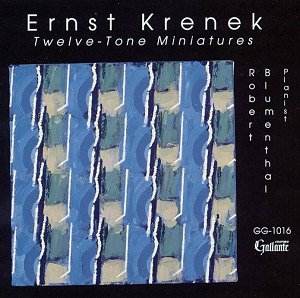Křenek’s
absorption of 12-tone music took practical
form on his emigration to America. He
published Music Here And Now
in 1939 – a revision of his earlier
1937 German text entitled Über
Neue Musik. As Roger Sessions maintained,
for Křenek promotion of the system
was “an artistic religion.” As these
works show however this was not mere
pedagogy, no dry as dust laying out
of wares. On the contrary the 1938 Twelve
Short Piano Pieces written in the Twelve-Tone
Technique is a consistently involving
and illuminating set of miniatures.
In the final result this set does not
adhere rigorously to 12-tone Schoenbergian
theory (in that it repeats previously
stated tones) but the pieces do achieve
a beauty and almost impressionistic
life that is constantly exciting and
engaging. Each piece has a descriptive
title – A Boat, Slowly Sailing,
On The High Mountains, Bells In The
Fog and so on – that might seem
to take the pieces into the realm of
late Romanticism or Impressionism –
which is surely the point. And they
also guide the ear, as well, suggestively.
Thus the opening Dancing Toys
skips deliciously for its minute length
and Walking on a Stormy Day is
full of bristle and incipient eruption.
Indeed The Sailing Boat, Reflected
In The Pond achieves an utter independence
of vision that more than once put me
in mind of someone like Takemitsu. The
veiling of the bells in the penultimate
Bells In The Fog seems to absorb
Debussy into its bloodstream and makes
for a most attractive elaboration of
technique whilst remaining essentially
true to its didactic purpose. It helps
that the miniatures are so beautifully
effective.
The
1946 Eight Piano Pieces is again
a less rigid demonstration of the Schoenbergian
process. Each piece is named – Etude,
Toccata, and Waltz etc – and, as the
composer hoped, one need not even recognise
the set for what it is, merely, in his
words "become aware of a certain
characteristic regularity of the design."
And that’s precisely what one does encounter,
from the brief but utterly gripping
Toccata to the ghostly Nocturne and
the splendid Rondo finale. Finally there
is the rather more austere Twenty
Miniatures of 1954. They’re based
on the same tone-row and form a kind
of theme and variations. Though clearly
less abrasive and jagged than Schoenbergian
procedure might ordinarily demand there
is still some tough writing scattered
throughout the set, though one can also
note the numerous moments of arresting
luminosity. Of them all the ninth, an
Adagio, has a shaft of elliptical delicacy
that simply stops one in one’s tracks.
I think it’s true to say that his contrapuntalism
is at its most sophisticated and sovereign
in this set.
Perhaps
the title of the album might put off
some readers. But with playing this
understanding and adroit, and with music
that fuses technique, education and
poetry with such distilled beauty –
not too strong a word – one can only
hope that Křenek’s functional music
(in the best sense of the word) will
continue to educate and to inspire.
Jonathan
Woolf
The
entire Gasparo Catalogue may now be
purchased through MusicWeb
